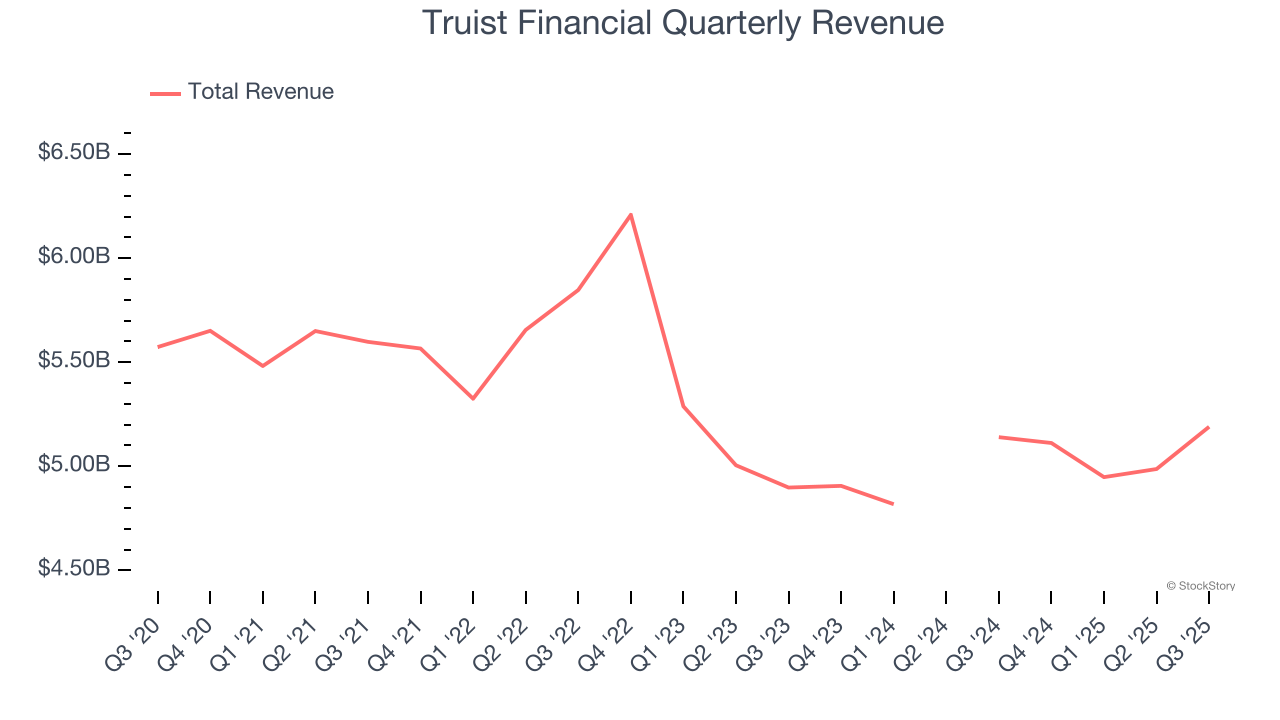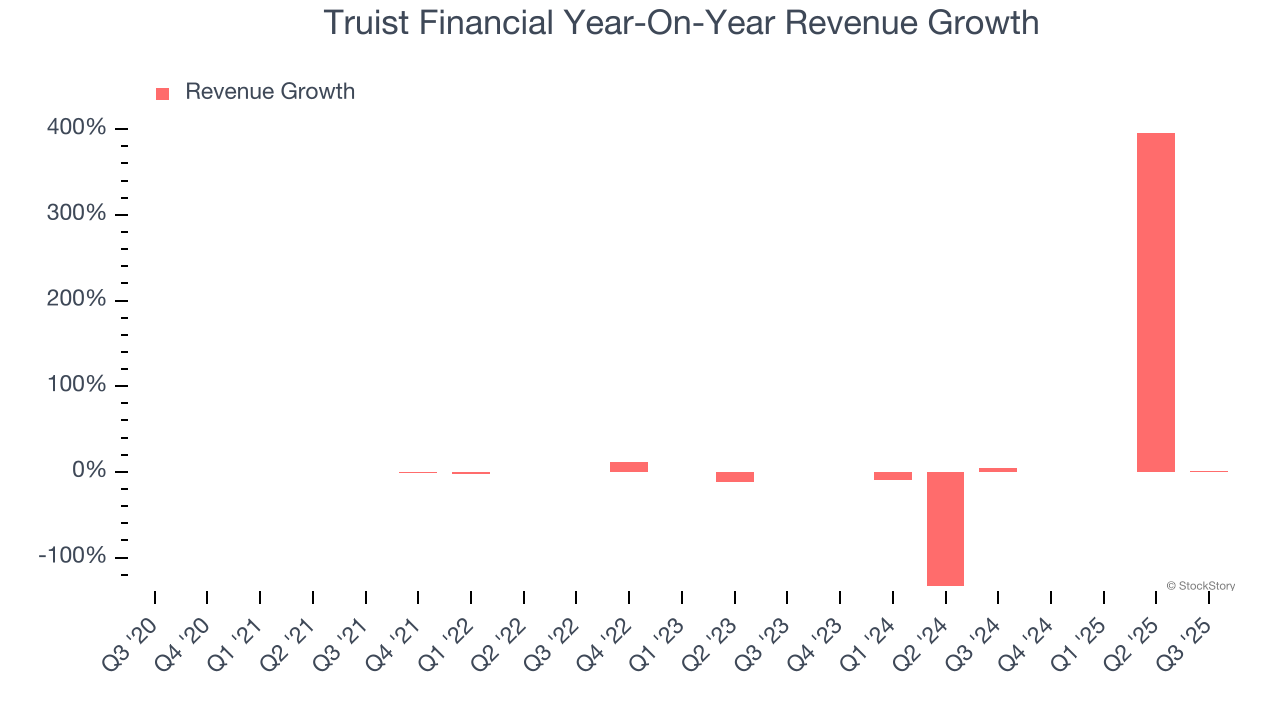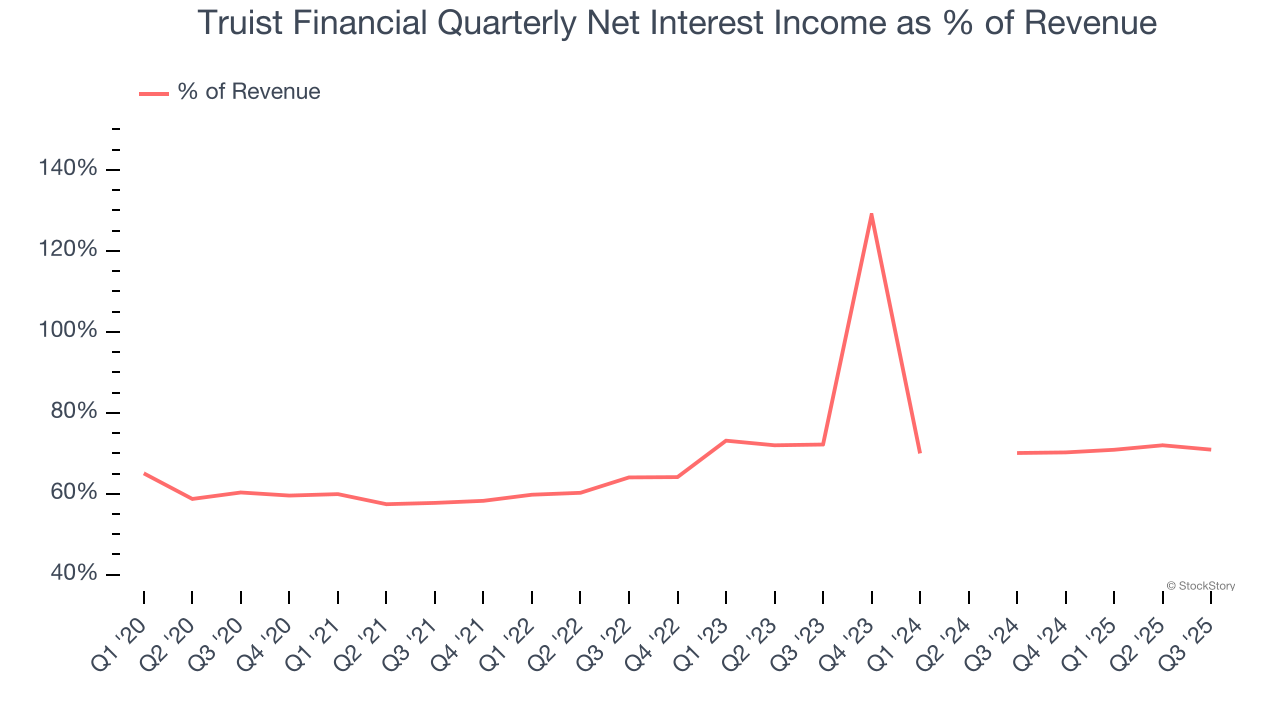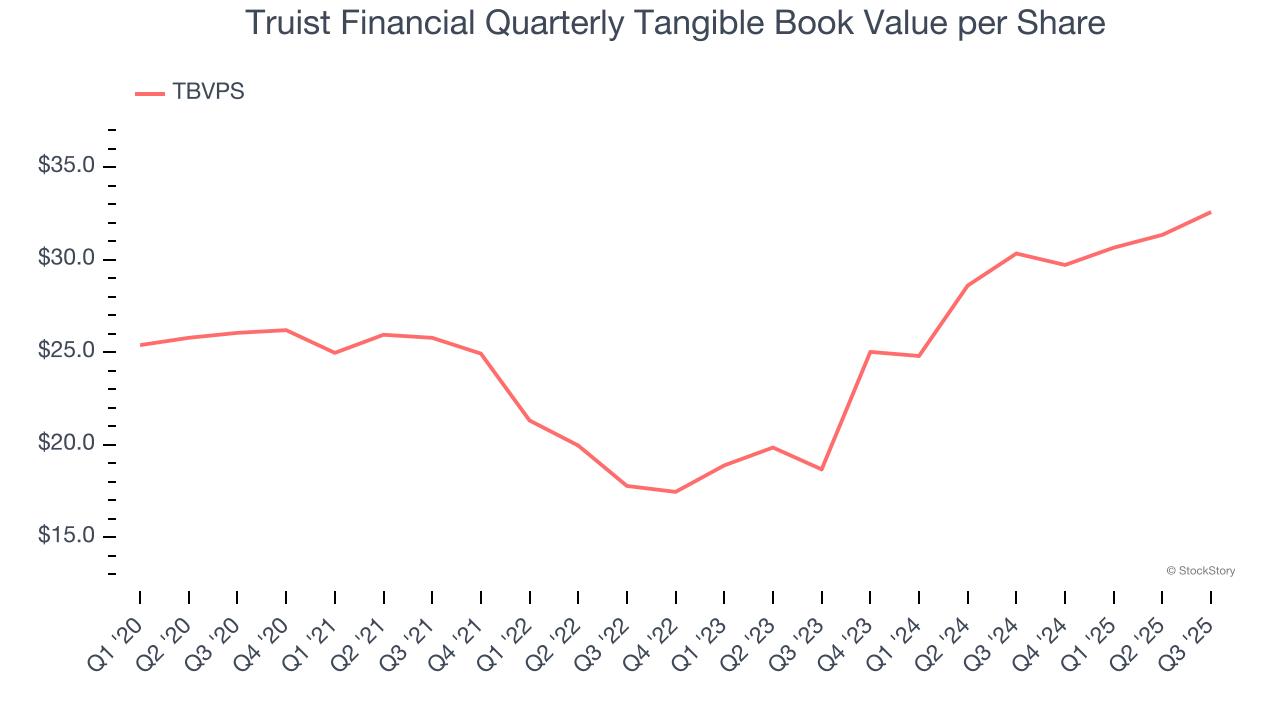
Financial services company Truist Financial (NYSE:TFC) reported revenue ahead of Wall Street’s expectations in Q3 CY2025, but sales were flat year on year at $5.19 billion. Its non-GAAP profit of $1.35 per share was 35.9% above analysts’ consensus estimates.
Is now the time to buy Truist Financial? Find out by accessing our full research report, it’s free for active Edge members.
Truist Financial (TFC) Q3 CY2025 Highlights:
- Net Interest Income: $3.68 billion vs analyst estimates of $3.70 billion (2.2% year-on-year growth, 0.5% miss)
- Net Interest Margin: 3% vs analyst estimates of 3% (3.5 basis point miss)
- Revenue: $5.19 billion vs analyst estimates of $5.15 billion (flat year on year, 0.7% beat)
- Efficiency Ratio: 58% vs analyst estimates of 56.8% (121.7 basis point miss)
- Adjusted EPS: $1.35 vs analyst estimates of $0.99 (35.9% beat)
- Tangible Book Value per Share: $32.57 vs analyst estimates of $31.87 (7.4% year-on-year growth, 2.2% beat)
- Market Capitalization: $52.98 billion
Company Overview
Born from the 2019 merger of BB&T and SunTrust in one of the largest banking combinations since the 2008 financial crisis, Truist Financial (NYSE:TFC) is a bank holding company that offers a wide range of financial services including consumer and commercial banking, wealth management, insurance, and lending solutions.
Sales Growth
Net interest income and and fee-based revenue are the two pillars supporting bank earnings. The former captures profit from the gap between lending rates and deposit costs, while the latter encompasses charges for banking services, credit products, wealth management, and trading activities. Unfortunately, Truist Financial struggled to consistently increase demand as its $20.24 billion of revenue for the trailing 12 months was close to its revenue five years ago. This wasn’t a great result and is a sign of lacking business quality.
 Note: Quarters not shown were determined to be outliers, impacted by outsized investment gains/losses that are not indicative of the recurring fundamentals of the business.
Note: Quarters not shown were determined to be outliers, impacted by outsized investment gains/losses that are not indicative of the recurring fundamentals of the business.Long-term growth is the most important, but within financials, a half-decade historical view may miss recent interest rate changes and market returns. Truist Financial’s recent performance shows its demand remained suppressed as its revenue has declined by 2.8% annually over the last two years.  Note: Quarters not shown were determined to be outliers, impacted by outsized investment gains/losses that are not indicative of the recurring fundamentals of the business.
Note: Quarters not shown were determined to be outliers, impacted by outsized investment gains/losses that are not indicative of the recurring fundamentals of the business.
This quarter, Truist Financial’s $5.19 billion of revenue was flat year on year but beat Wall Street’s estimates by 0.7%.
Net interest income made up 55.1% of the company’s total revenue during the last five years, meaning Truist Financial’s growth drivers strike a balance between lending and non-lending activities.
 Note: Quarters not shown were determined to be outliers, impacted by outsized investment gains/losses that are not indicative of the recurring fundamentals of the business.
Note: Quarters not shown were determined to be outliers, impacted by outsized investment gains/losses that are not indicative of the recurring fundamentals of the business.Markets consistently prioritize net interest income growth over fee-based revenue, recognizing its superior quality and recurring nature compared to the more unpredictable non-interest income streams.
Here at StockStory, we certainly understand the potential of thematic investing. Diverse winners from Microsoft (MSFT) to Alphabet (GOOG), Coca-Cola (KO) to Monster Beverage (MNST) could all have been identified as promising growth stories with a megatrend driving the growth. So, in that spirit, we’ve identified a relatively under-the-radar profitable growth stock benefiting from the rise of AI, available to you FREE via this link.
Tangible Book Value Per Share (TBVPS)
Banks operate as balance sheet businesses, with profits generated through borrowing and lending activities. Valuations reflect this reality, emphasizing balance sheet strength and long-term book value compounding ability.
This is why we consider tangible book value per share (TBVPS) the most important metric to track for banks. TBVPS represents the real, liquid net worth per share of a bank, excluding intangible assets that have debatable value upon liquidation. EPS can become murky due to acquisition impacts or accounting flexibility around loan provisions, and TBVPS resists financial engineering manipulation.
Truist Financial’s TBVPS grew at a mediocre 4.6% annual clip over the last five years. However, TBVPS growth has accelerated recently, growing by 32.1% annually over the last two years from $18.67 to $32.57 per share.

Over the next 12 months, Consensus estimates call for Truist Financial’s TBVPS to grow by 4.8% to $34.15, paltry growth rate.
Key Takeaways from Truist Financial’s Q3 Results
It was good to see Truist Financial beat analysts’ EPS expectations this quarter. We were also happy its tangible book value per share outperformed Wall Street’s estimates. On the other hand, its net interest income slightly missed. Overall, we still think this was a solid quarter with some key areas of upside. The stock traded up 1.2% to $41.55 immediately after reporting.
Sure, Truist Financial had a solid quarter, but if we look at the bigger picture, is this stock a buy? If you’re making that decision, you should consider the bigger picture of valuation, business qualities, as well as the latest earnings. We cover that in our actionable full research report which you can read here, it’s free for active Edge members.
